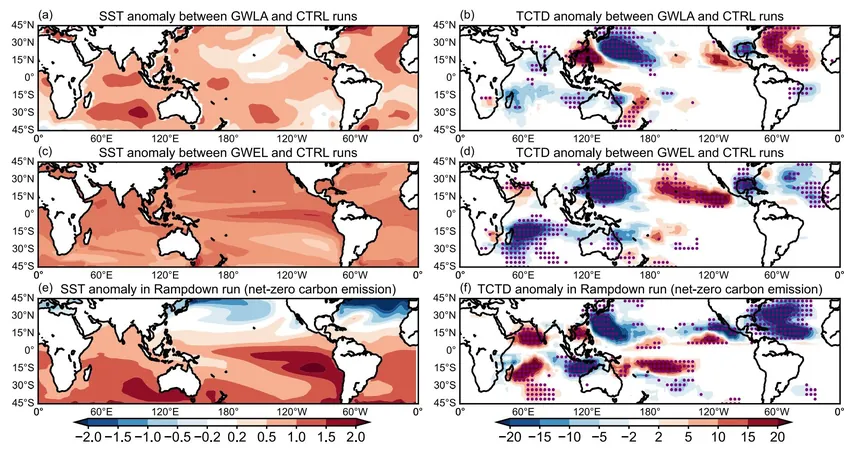
Unlocking the Secrets of Tropical Cyclones: How Ocean Warming Patterns Shape Our Future
2025-06-26
Author: Wei Ling
Revealing the Link: Ocean Warming and Tropical Cyclones
A groundbreaking review featured in *Advances in Atmospheric Sciences* unveils a pivotal mystery in climate science: the intricate relationship between tropical ocean warming patterns and the behavior of tropical cyclones (TCs) amidst a warming world. An international consortium of scientists has meticulously synthesized decades of observational data and advanced climate models to pave the way for more accurate hurricane forecasts.
The Costly Threat of Tropical Cyclones
Tropical cyclones rank among the most devastating weather events, both in loss of life and economic impact. Yet, our capacity to predict their future activity remains frustratingly inadequate. The research team discovered that a significant hurdle lies in the conflicting influences of tropical sea surface temperature (SST) patterns on cyclone behavior.
Diverging Climate Models: A Major Challenge
Since the 1950s, observations have consistently indicated a La Niña-like warming trend, with cooler conditions in the eastern tropical Pacific. In stark contrast, over 80% of CMIP6 climate models predict an opposite El Niño-like trend, promoting warming in the same region. According to Yuqing Wang, the lead author and a professor at the University of Hawaii at Manoa, these discrepancies—rooted in biases related to cloud feedback, ocean dynamics, and broader atmospheric circulation—carry enormous implications.
The Ripple Effect on Cyclone Projections
Because tropical SST patterns play a critical role in shaping when and where TCs form and how strong they become, inaccurate SST forecasts can lead to vast uncertainties in predicting cyclone activity. The team emphasizes the need to clarify how varying warming patterns affect TCs, advocating that any reliable cyclone forecasts must be based on accurate representations of these patterns.
A Promising Approach to Reduce Uncertainty
Prof. Wang highlights the potential of 'pattern-conditioned' methodologies utilizing high-resolution, convection-permitting models. Unlike traditional models, these advanced systems can effectively simulate TCs and their reactions to warming, yielding insights into rapid intensification and storm structure.
Understanding Global Interactions
The research team also points to the significance of inter-basin interactions—like how warming in the Indian and Atlantic Oceans can enhance La Niña-like conditions in the Pacific, further influencing global TC patterns. Consequently, a comprehensive evaluation of TCs requires a global perspective on SST dynamics and their reciprocal effects.
A Call for Coordinated Research Efforts
To advance the science of tropical cyclone projections, the team urges a united effort to merge storm-resolving global models, corrected SST pattern scenarios, and physics-informed diagnostics. This approach aims to not only accurately depict storm structures but also to validate underlying SST influences.
Charting a Safer Future
Future inquiries should prioritize ensemble simulations that explore diverse warming scenarios, incorporate evolving SST anomalies, and rigorously assess model fidelity against actual climate variability. These strategies are imperative to enlighten us on how cyclone dynamics may shift under various climate pathways—essential knowledge for long-term risk assessments, infrastructure design, and climate resilience strategies.
As extreme weather events become more frequent, this review underlines a crucial takeaway: to effectively forecast the trajectory of tropical cyclones in a warming climate, we must first decode the patterns found in our oceans.

 Brasil (PT)
Brasil (PT)
 Canada (EN)
Canada (EN)
 Chile (ES)
Chile (ES)
 Česko (CS)
Česko (CS)
 대한민국 (KO)
대한민국 (KO)
 España (ES)
España (ES)
 France (FR)
France (FR)
 Hong Kong (EN)
Hong Kong (EN)
 Italia (IT)
Italia (IT)
 日本 (JA)
日本 (JA)
 Magyarország (HU)
Magyarország (HU)
 Norge (NO)
Norge (NO)
 Polska (PL)
Polska (PL)
 Schweiz (DE)
Schweiz (DE)
 Singapore (EN)
Singapore (EN)
 Sverige (SV)
Sverige (SV)
 Suomi (FI)
Suomi (FI)
 Türkiye (TR)
Türkiye (TR)
 الإمارات العربية المتحدة (AR)
الإمارات العربية المتحدة (AR)